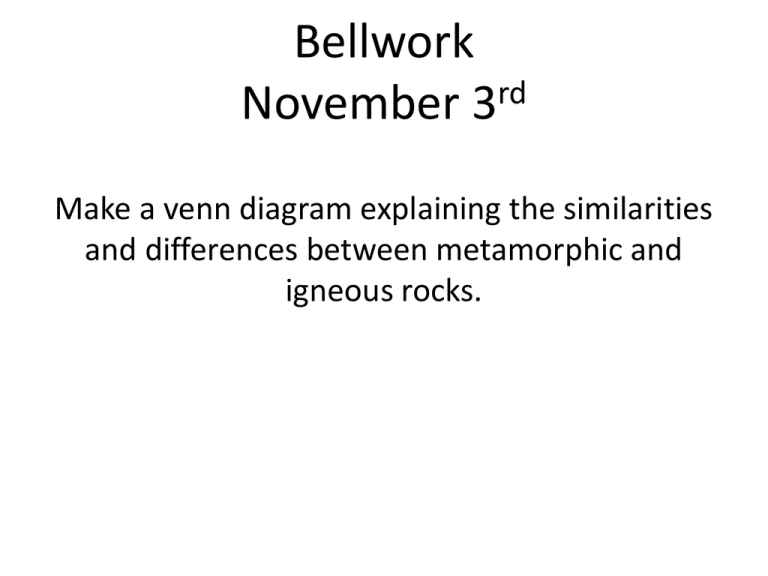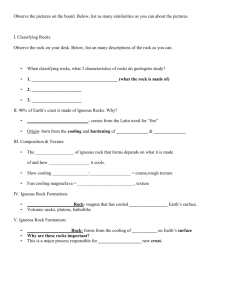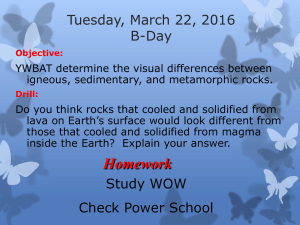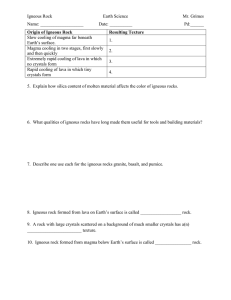File
advertisement

Bellwork November 3rd Make a venn diagram explaining the similarities and differences between metamorphic and igneous rocks. Igneous Rocks How Does Igneous Rock Form? • Form when hot, liquid rock (magma) cools and hardens How Does Magma Form? 1. Increase in temperature: when temperature increases, minerals in rock melt 2. Decrease in pressure: if hot rock rises to the surface, the pressure goes down, and the rock will melt 3. Addition of fluids: when fluids mix with rock, the rock’s melting temperature decreases and the rock can melt Check for Understanding • Give three ways that magma can form. How Do Igneous Rocks Form, cont. • • • • • When magma cools, mineral crystals form Similar to ice Magma = different compounds Compounds = different minerals Each mineral becomes solid at different temperatures • As magma cools, different parts become solid at different temperatures How Do Igneous Rocks Form? Magma Cools Mineral Crystals Start To Form Magma Cools More Igneous Rock Form Check For Understanding • Why do different parts of magma become solid at different times? How Are Igneous Rocks Classified? • Composition • Texture Composition – Felsic • • • • Rich in Sodium, Potassium, and Aluminum Combine to make light-colored minerals Felsic igneous rocks are light-colored Examples are granite and Rhyolite – Mafic • • • • Rich in Iron, Magnesium, and Calcium Combine to make dark-colored minerals Mafic igneous rocks are dark-colored Examples are gabbro and basalt Check for Understandin • Give two differences between felsic and mafic igneous rocks. Texture • Texture of any rock is determined by the sizes of the grains in the rock • Texture of an igneous rock depends on how fast the magma cooled • Cools fast – small crystals form (fine-grained texture) • Cools slow – large crystals form (coarsegrained texture) Check for Understanding • Give an example of a felsic, fine-grained igneous rock. • Give an example of a mafic, coarse-grained igneous rock. Texture: Intrusive Igneous Rocks • Intrusive Igneous Rocks – Forms when magma cools below the Earth’s surface – Magma cools slowly, so most will have coarsegrained texture Check for Understanding • Write your own definition for intrusive igneous rock. Texture: Intrusive Igneous Rocks Volcanic Neck – forms when a dike or stock is exposed to the surface. The rock around it erodes away and only the igneous rock is left behind Stock – large body Batholith – of intrusive rock largest kind of intrusive rock body Sill – sheetlike body of intrusive rock that is parallel to other Dike – rock layers sheetlike body of intrusive rock that cuts across other rock layers Check for Understanding • Give four kinds of intrusive rock bodies. Extrusive Igneous Rocks • Extrusive Igneous Rocks – Forms when lava cools – Common around volcanoes – Lava cools quickly, so most will have fine-grained texture Check for Understanding • Why do extrusive rocks have very small crystals or no crystals?






